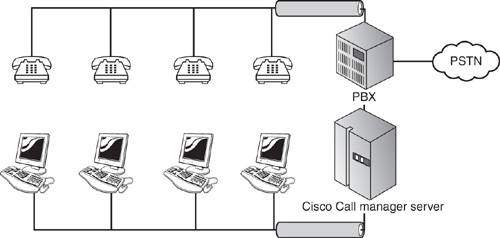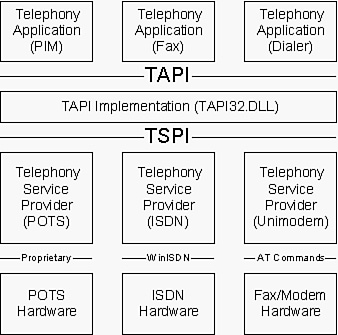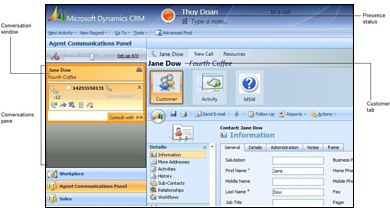1. TAPI Architecture Defined
From the end-user perceptive, the
architecture of a digital telephone integration is simple: End users
have a physical phone and a computer that has the TAPI client that
interacts with the phone system. Figure 1 shows the physical layout from an end-user perceptive.

However,
the software behind the functions has a lot of complex integration.
Several software interface layers allow endless possibilities for
integration. Figure 2
shows the different interfaces available. For example, you can have an
array of different phone systems (VoIP solutions from Avaya and Cisco,
and you can have non-VoIP solutions that can interface with TSPI) and
services that are potentially connected in the TSPI layer. The TSPI
interface unifies all communication for the TAPI to be used for the
end-user solution.

A practical use for this applies to this scenario:
We have various call centers distributed throughout the world using
different phone systems, but the company has a single CRM solution using
Microsoft Dynamics CRM. So, when the customer calls any call center in
the company, the TAPI client should be able to query the CRM system.
The TAPI layer, as shown in the Figure 7.2,
can be connected to several hardware interfaces. Therefore, you can use
a spectrum of physical phones and have a mixed environment.
2. Telephony Manufacturers/Third-Party Solutions (SIP-Based Solutions)
The telephone manufacturers mentioned in this
section have partnered with Microsoft to develop their own solutions for
their telephone systems, and offer out-of-the-box solutions for
integration with Microsoft Dynamics CRM.
2.1 Microsoft Office Communication Server (OCS) R2 Agent Communications Panel for Microsoft Dynamics CRM 4.0
The Agent Communications Panel is integrated into
the Microsoft Dynamics CRM 4.0 web application. The Agent
Communications Panel enables users to telephone others (to make and
receive calls), to instant message (IM) co-workers and customers, and to
make conference calls. The link between your communication system and
the Microsoft Dynamics CRM application enables you to have access to all
of your customer information.
Figure 3 shows a sample of the Agent Communications Panel interacting with Microsoft Dynamics.

Note
This integration was primarily designed for service agents. However, this solution can be used by salespeople, too.
The Agent Communications Panel has the following components:
The Conversations pane displays active conversations.
The
Customer tab enables you to access the customer information for the
active conversations. You can view and edit the customer contact or
account form. You can also add a new activity record to log your
conversation.
The New Call tab enables
you to contact customers or colleges. You can communicate with the
customers or other contacts via telephone or IM.
You can also manage your Contacts list.
Share presence status with others. You can choose to grant more access to certain teams regarding your status.
Switching between voice devices enables you to be able to switch phones without the other person noticing a difference.
Note
This
is a SIP-based system, designed for the new server-client communication
system. Microsoft Office Communicator 2007 R2 is supported.
Server Components
Requirements: Ensure that .NET 3.5 SP1 is
installed on both the server and the client machines running Microsoft
Dynamics CRM 4.0.
Installing the Agent Communications Panel
1. | Log on to the server as a Microsoft Dynamics CRM deployment administrator.
|
2. | Launch the install package.
|
3. | Review and accept the license agreement, and then click Install.
|
4. | Click Finish.
|
Customizing the Agent Communications Panel
With the Agent Communications Panel, you can
customize organization-specific elements on the user interface. The
following customizing options are available:
Configure the Response Group Service
feature. This enables you to have a communication agent system in your
organization. This feature allows you to have specialized groups of
people in the call center who can help customers based on the data in
certain fields.
Change the default form
for the customer information. Allows companies to use the same contact
record and have a customized form for different groups of people (Sales,
Marketing, or Service).
Create custom buttons. Allows quick-access buttons with customized functions.
Configuring the Response Group Service Integration Feature
The Response Group Service is a new feature in
Microsoft Office Communications Server 2007 R2. This is a powerful
feature that can help direct the communication and the information
directly to the engaged user.
It enables administrators to create and
configure workflows to route and queue incoming conversations. For
example, if an engineer requires assistance from the product company,
the engineer places a call to the service call center for the product.
The Communication Server should retrieve the relevant information about
the caller from the Microsoft Dynamics CRM system. The Communication
Server can initiate a workflow, which can analyze the call time and the
caller and refer to a scheduled activity. At that point, the system can
transfer the call to the person with the specialized skills to handle
it.
To configure the Response Group Service integration feature, follow these steps:
1. | In the CRM application, select Settings, Agent Communications Parameters.
|
2. | Open
ResponseGroupServiceIntegration. To enable the Response Group Service
integration feature, set Parameter Value to True, and then click Save
and Close.
|
3. | Open
ResponseGroupServiceWebServiceUri. Enter the URL of the Response Group
web service (https://<OCS_Server>/rgs/clients/ProxyService.asmx),
and then click Save and Close.
|
Changing the Default Form for the Customer Information
You can specify the form that displays when a
user clicks the Customer button under the Customer tab. The customer
information can be displayed in either the contact or account form. The
contact form is the default view used.
To change the default form, follow these steps:
1. | In the CRM application, select Settings, Agent Communications Parameters.
|
2. | Open CustomerFormDisplayed, set Parameter Value to either Contact or Account, and then click Save and Close.
|
Creating Custom Buttons
You can create custom buttons to add to the
Agent Communications Panel user interface. Custom buttons can be added
to either the Customer or Resources tab and can be used to support
applications such as call scripting and knowledge bases.
Note
The maximum number of buttons allowed per tab, including the default buttons, is 10.
To create a custom button, follow these steps:
1. | In the CRM application, select Settings, Agent Communications Buttons.
|
2. | Select New. Then enter the appropriate values:
Name: Enter the display name for the button.
Target URL: Enter the URL for the resource.
Tool Tip: Enter the text to display on mouse over.
Icon URL: Enter the path to the image file of the button icon.
Button Order: Select the button placement order. The button order in each of the tabs is oriented from left to right.
Tab Location: Select either Customer or Resources to specify the location of the custom buttons
Note
If the custom button is placed on the
Customer tab, the customer or account ID is appended to the target URL
when the button is launched. This enables you to reference the customer
or account ID in your application.
|
3. | Click Save and Close. |